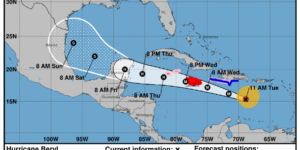Characterizing the reinsurance market as a “transitioning” one, Guy Carpenter saw signs of easing property pricing, higher demand and more scrutiny on casualty programs, the reinsurance broker said in a July 1 market summary.
The preliminary midyear Guy Carpenter U.S. Property Catastrophe Rate on Line (ROL) Index is nearly flat year-on-year, the reinsurance broker said in a statement. (Thos index is a measure of price change that incorporates the impact of structural adjustments and current views of risk on actual dollars paid.)
Loss-free property programs generally saw easing of pricing, even as demand increased.
Casualty programs were completed with adequate capacity, but pricing and underwriting scrutiny persisted due to a variety of market trends. Reinsurers maintained focus on the vulnerability of cedent portfolios to economic and social inflation. Those that demonstrated reduced volatility through controlled and limited capacity deployment saw better ultimate terms and conditions.
The statement and an accompanying report offered these additional insights on midyear 2024 renewals:
- Most property placements were completed early to on time. Risk programs remained under scrutiny amid continued concerns about the frequency and severity of large risk losses.
- Global property catastrophe reinsurance risk-adjusted rates at midyear were generally flat to down mid- to high-single digits. In some cases, upper layers were risk-adjusted down 10 percent or more for non-loss impacted accounts, in a moderating but still robust pricing environment.
- Overall, property renewals did not experience major restructuring, and in some instances, improved terms were achieved.
- Casualty renewal outcomes varied by sublines as well as reinsurance type. General liability and excess/umbrella placements that are U.S.-exposed experienced continued reinsurance pricing pressure for excess of loss programs—with increases ranging from 1-5 percent for better performing programs and from 2.5-10 percent for loss-impacted ones. Quota share outcomes were tied to the amount of adverse development.
- In general, placement results for casualty programs remained dependent on “highly technical, data-driven insights.” This entailed quantifying mitigation of prior-year developments in many areas of going-forward portfolios as well as addressing portfolio rate changes relative to loss trends.
- For financial lines, there was continued downward pressure on ceding commissions. This was driven by public directors and officers (D&O) portfolio concentration, underlying rate environment and continued prior-year development.
- Reinsurance buyers in the cyber reinsurance market saw improved terms across all structures. The mid-ear cyber renewals also saw ongoing interest in alternative structures including event-based covers, continuing a trend observed at January 1.
“The reinsurance industry has responded to measurably increased demand in 2024, which has materialized at a level above many expectations,” said David Priebe, Chairman, Guy Carpenter.
“Reinsurers’ attractive returns and improved capital positions are facilitating increased capacity in several sectors,” he said.
Demand increases were also apparent for retrocessional cover. In particular, there was more demand for retrocessional coverage during the second quarter—from existing buyers along with historical buyers returning to the market—with improved purchasing dynamics relative to 2023, underlying portfolio growth and active North Atlantic wind season forecasts driving demand.
Outside of the traditional reinsurance market, catastrophe bonds had a record first half of the year. By June 24, 47 different catastrophe bonds were brought to the 144A market for approximately $11.9 billion in limit placed.
Source: Guy Carpenter





















 Change Management Best Practices for P/C Insurers
Change Management Best Practices for P/C Insurers  Liability Reinsurance Crisis Could Be Looming, CEO Says
Liability Reinsurance Crisis Could Be Looming, CEO Says  GEICO Tops Progressive With Higher J.D. Power Scores
GEICO Tops Progressive With Higher J.D. Power Scores  Berkshire, Starr in Top Cyber Ranking; Global Outlook Stable: AM Best
Berkshire, Starr in Top Cyber Ranking; Global Outlook Stable: AM Best 